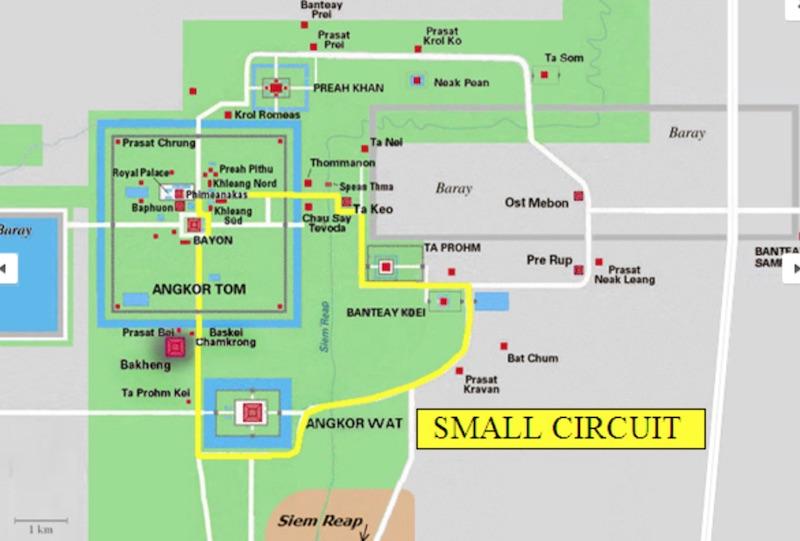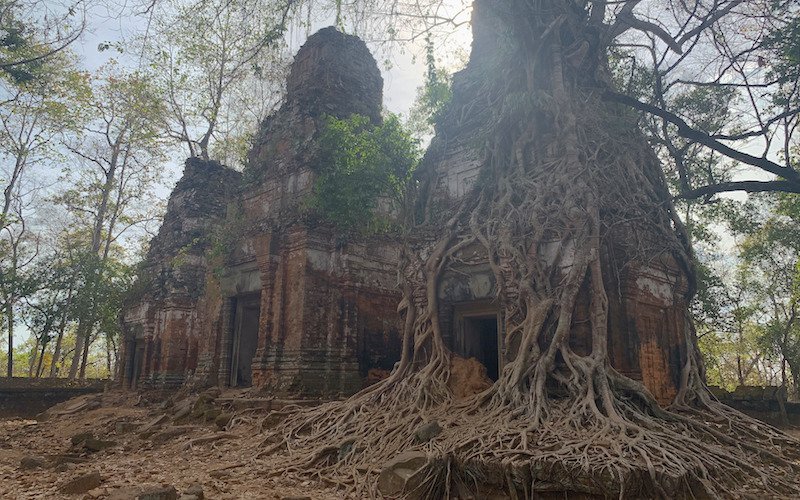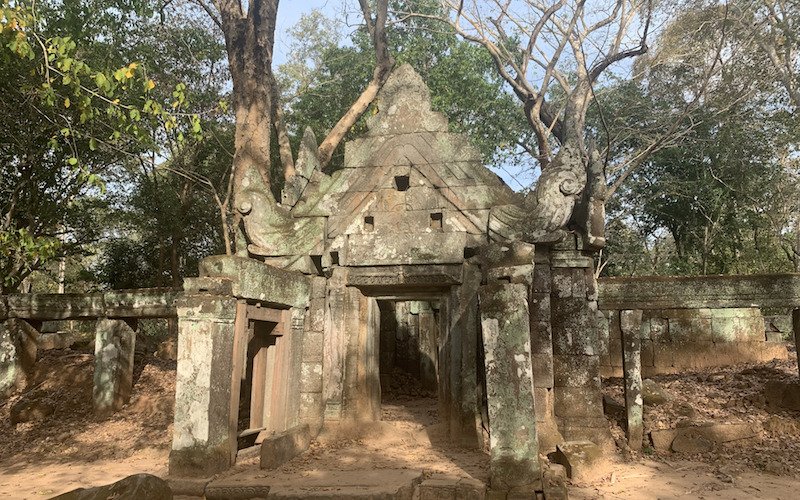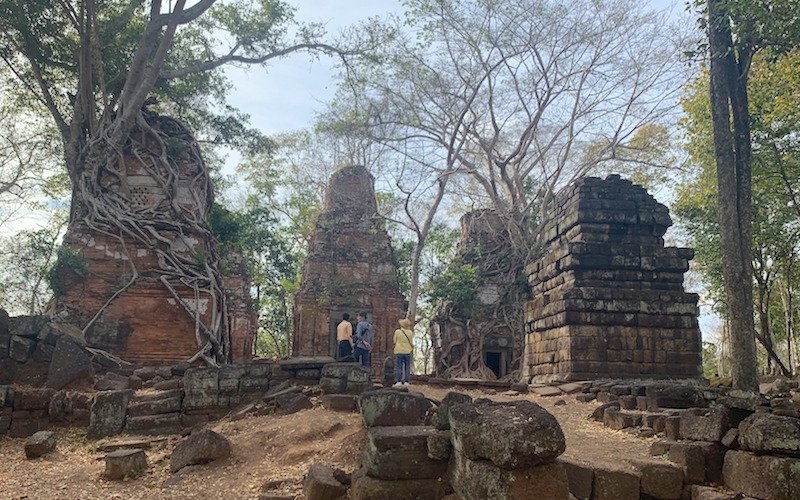If you are looking for ancient temples that are a little bit different and less crowded during your stay in Cambodia, visit the Koh Ker temples. Koh Ker Archaeological park is smaller than Angkor Wat but offers a great deal of history and a pyramid style ‘pièce de résistance’.
Visiting the Koh Ker Temples
Spend a full day to travel to and look around Koh Ker if possible. Many people combine it with Being Maelea temple as a day trip from Siem Reap which is a reasonable option.
It’s also possible to combine your visit to Koh Ker with Preah Vihear temple on the Northern Thai border. I visited Koh Ker as a day trip from Siem Reap and combined it with Preah Vihear in the same day. It’s doable but knackering and so I recommend doing each of these as individual day trips.
Or you could stay overnight at Preah Vihear and then travel to Koh Ker on the morning of your second day – especially if you like ample time to explore temples without being rushed.
It’s possible to stay overnight in Koh Ker village – I recommend a night at Koh Ker jungle lodge if you don’t mind something remote and authentic.
The ticket system for Koh Ker works similar to the Angkor Wat Tickets – you pay $10 for your ticket and this gets you into all of the Koh Ker temples.
History of Koh Ker (Cambodia)
The city of Koh Ker was once the capital of the Khmer Empire between 928 AD – 944AD during the reigns of Harshavarman II and Jayavarman IV. Imagine this city as it was – a thriving, busy hub – as you explore the now dilapidated carved sandstone rubble that would once have been home to over 10,000 inhabitants.
An exceptional seven-tiered pyramid structure, called Prang, burrowed in jungle and yet towering proudly at 36 metres tall, rules this less known archaeological site around 120 km north east of Siem Reap. Go through the striking sandstone entrance pavilion and pass two laterite towers, which are now moss-covered ruins. What were once prayer or meditation ‘palaces’ made for noble kings can be viewed on the eastern side, along with temple complex Prasat Thom, whole with its moat.
The pyramid itself, located in the western side of the complex, is believed to have been the state temple. A wooden staircase with handrail has been made to let visitors to climb to all but the top tier. The seventh tier is supposed to be where a plinth supported a four-metre-high linga worshipping Hindu deity, Shiva.
Why Koh Ker is a good quiet alternative to Angkor War
Koh Ker stays off the beaten path for tourists visiting Cambodia, but its reputation is growing. The temple complex, once filled with landmines, was only made open to tourists fairly recently. The main temple trail has been safely cleared of landmines by the APOPO HeroRats. The area as a whole has not been completely de-mined, but a fraction of all the former capital’s temples can be visited and are clearly identified on the tourist trail. Koh Ker continues to be known as one of the most mysterious and impressive archaeological sites you can visit in all of Cambodia.
The main temple is called Prasat Thom, and that’s where you will find the large seven-tiered pyramid. But as Koh Ker was originally its own city, there are a large number of other temple ruins to discover as well. The road forms a loop so it’s hard to get lost. Coming from the south, you’ll pass by 3 or 4 temples before Prasat Thom, and around 10 structures of varying sizes after it. Most people only bother to stop at Prasat Thom, so you’ll likely have the minor ruins all to yourself.
The journey can be completed easily by car and bike. If you take a taxi from a nearby town, you’ll come across a bicycle rental stand in front of the main temple to help you get around. Or, if you’ve hired a private driver, he can just drive you along the route and stop for you to get out at each temple. Visiting the Koh Ker temples is more of a challenge by bicycle mainly due to the heat and the terrain, but it is possible for fit and confident cyclists.
How to get to Koh Ker – day trip from Siem Reap
Arrange a private taxi to Koh Ker. The enjoyable 2.5-hour drive from Siem Reap takes you along good roads with views of banana and cashew plantations and rice fields along the way. The Kulen mountain route can be combined easily with a visit to Koh Ker and Beng Mealea. Just inside the car park at Koh Ker, you’ll find drinks kiosks, restaurants and a small selection of market stalls selling souvenirs and fresh coconut drinks.
Tickets for Koh Ker (prices are $10 adults, children under 12 years go free) can be bought at the Beng Mealea ticket booth. There are bathrooms at both the ticket kiosk itself, and at the ticket check point closer to Koh Ker, which has picnic benches.
Map of Koh Ker Temples
Sorry my map resource is in German! But you can see that you simply follow the main temple loop ending up at Prasat Thom.

The main temples of Koh Ker
Prasat Pram
The first temple that you come to – Prasat Pram – is a well-preserved Koh Ker temple which follows a standard 10th century temple layout. You’ll find three prasat sanctuaries lined in a row, with the two structures in front being what are known as ‘libraries.’ While we don’t know exactly what the libraries were for, they either contained manuscripts and idols or were used for ceremonies in honor of the fire god Agni.

Prasat Pram is gradually merging with the jungle, giving off vibes similar to the famous ‘Tomb Raider Temple’ of Ta Prohm.
Prasat Naeng Khmer
Next on the right is Prasat Naeng Khmau, an early 10th Century temple whose name means ‘black lady’. Many presume that the temple is so called due to its back charred surface. However, my driver told a different story – there was a beautiful black lady who was the daughter of the temple owner or King. She was in love with her bodyguard, but at that time it was forbidden for them to marry.
I’m not sure whether this is truth or legend, but the temple is a beautiful one with an active shrine inside. I saw a worship ceremony going on the first time we past this temple.
Prasat Khnar
Prasat Khnar is a somewhat mysterious temple for a number of reasons. Scholars now believe that the large pedestal once housed a huge linga which reached up to 3 meters. Like the linga from the top of Prasat Thom’s pyramid, however, nothing of it remains. Over to the side, you’ll also find carvings of animals and gods in the stone. It’s very reminiscent of the carvings atop Mt. Kulen at a place called Kbal Spean. Typically, carvings in stone like this are very rare at ancient Khmer ruins.
Prasat Damrei
Prasat Damrei means ‘Elephant temple’ and despite being quite dilapidated, this 10th Century temple is worth a visit for the guardian elephants on each corner of the platform.
Linga 1
Along the Loop there are several Linga temples (a Lingum is a phallic symbol representative of Hindu God Shiva). Only the first one has a well preserved Lingum inside and so it’s worth seeing this, but you can then skip the other identical Linga temples as they have nothing inside.
Prasat Krachap
Prasat Krachap has two beautifully preserved goporas or gates that echo the style of Preah Vihear. The five temples in the centre are reasonably intact. Prasat Krachap was dedicated in 928 to Tribhuvanadeva, a linga representation of Shiva.

Prasat Chen
This temple follows the identical layout as Prasat Pram, but it was one of few temples dedicated to Vishnu in the city. Today, the prasats are in a poor condition and overall, the temple looks quite unassuming. The main gate is completely collapsed and the main temples are partially collapsed.
However, it was at this very temple, where some of the best masterpieces of Khmer sculpture art were first discovered. The eastern tower once had a sculpture of a scene from the Ramayana epic of Valin battling Sugriva.
While that was discovered in 1952, another massive discovery was made here as newly as 2012. Archaeologists found a group of statues portraying Duryodhana fighting Bhima, a huge scene from the Mahabharata epic. But that’s not all. In 2014, researchers found three more pedestals with nothing left but the statues’ feet. Obviously, the statues had all been looted at one point. One of them turned out to be a well-known statue of Hanuman that had long been kept at the Cleveland Museum of Art. Once the correlation was made, it was returned to Cambodia the following year.
Prasat Thom
Prasat Thom was Jayavarman IV’s state temple, equivalent to Angkor Wat or the Bayon of later Khmer kings. While the main highlight is the massive standalone pyramid, signified to as the ‘Prang,’ there were also a few buildings east of the main pyramid. To begin with, you will first encounter a structure made up of long halls in the shape of a cruciform. Heading further west, you’ll see a large brick prasat sanctuary that remains in good condition.
The causeway, surrounded by a moat on either side, is one of the most interesting parts of Prasat Thom. Obviously, there were once some long structures that were supported by columns there, many of which have collapsed since. A lot of the buildings were possibly made of wood, long since rotted, like the gates of Preah Vihear. In the temple area, you’ll see plenty of other structures, mainly prasat sanctuaries, libraries, galleries and gates. Some of which are still standing, but a lot have been reduced to rubble.
Practical Tips for visiting the Koh Ker Temples
- There are toilets but only at by the main ticket office, and not nearby every temple like Angkor Archaeological Park.
- There are stalls where you can buy a drink near the main temple.
- Wear comfortable walking boots as a lot of the area is jungle.
- Don’t go off the main temple path (it’s jungle!)
- Dress conservatively covering your legs and shoulders.
- Allow at least 2-4 hours to explore Koh Ker.
Further Reading
If you enjoyed this blog on the Koh Ker temples, you may also like to read about Preah Vihear and the Roluous group temples. If you are staying in Siem Reap and visiting the temples of Angkor Archaeological Park, you might enjoy my Ultimate Angkor Wat Guide and this Angkor Wat Grand Circuit guide.

